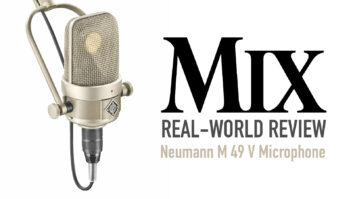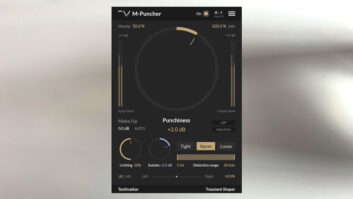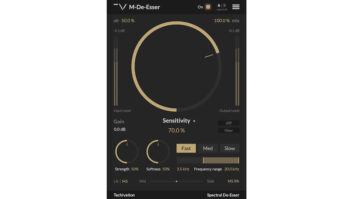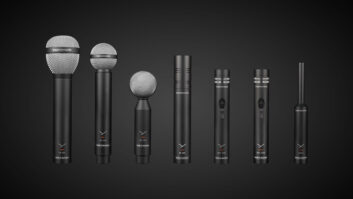The concept of a central server system that routes digital audio throughout a multi-room studio facility is not new. In fact, there has been a trend toward central server implementations in audio post for several years. But the concept has only just begun to gain acceptance in multi-room music recording studios, a delay partly attributable to the costs of linking three, four or more rooms to multiple RAID array systems and their attendant controller systems via kilometers of cable.
But the proliferation of hard disk recording, and the use of Pro Tools in particular, has made the adoption of the central server model for music recording an inevitability.
In general, audio post houses manage the distribution of digital audio through a central server in a much different manner. In audio post, the individual music selections tend to be smaller, even if they are bits of a larger enterprise, such as a film score. Post houses routinely deal with packets of audio that are as small as a second or two in length. Even entirely finished projects might be no longer than a 15-second television spot. But audio post houses also deal with an enormous number of discrete musical projects, with literally thousands of elements being shifted from one studio to the next as the assembly progresses. Many of the musical elements, such as library sounds and sound effects, are frequently re-used, and projects often need to be turned around in a matter of days or hours. Storing, shuttling, retrieving and managing lots of little bits of digital data on a frenetic schedule are exactly the kinds of tasks that server-based networks are designed to handle.
Music facilities, on the other hand, regularly handle longer pieces of audio, for longer periods of time, and producers or production teams may use several rooms in the same facility simultaneously as individuals and teams work on multiple projects in various stages of development.
“In music, it’s still sort of a puzzle for which all the pieces don’t yet exist, so you have to make them up as you go along,” observes John Klett, whose upstate New York-based companies Singularity and Tech Mecca have designed and installed a number of central server systems in music facilities. Klett’s designs are now in use at both of producer Mutt Lange’s private studios, one in New York’s Adirondacks region, the other in Switzerland.
The first server project Klett designed and installed was at Plantain, a Manhattan music studio connected to a film production company. “It was a pretty simple system,” Klett says of the project, completed two years ago. “The goal was to get audio back and forth to the Avid editing rooms and to send compressed video files to the music rooms. I set up a Mac OS-X server connected to one big disk and had them organize the work in file folders, to make tracking projects easier. You can use an assortment of off-the-shelf components to do this. But that basically sets the tone for what any server in a music application has to be. And you can see that music has different demands from post-production.”
As Klett notes, much of the digital audio data management technology on the market has been developed with post in mind; mSoft, for example, is geared toward managing sound effects files. “But the architecture does let you use it for music clips as well,” says Klett. “You’re still moving data between digital audio workstations on a network. It’s a mature technology, but it’s also primitive in the sense that there’s no specialized structure of server technology that’s specific to music production, one that can adapt to the less rigid ways of working you find in music, as opposed to post.”
THE VILLAGE EXPERIENCE
That’s pretty much what Jeff Greenberg of The Village found when he decided to connect four main rooms with a central server. When Greenberg opens the door on the equivalent of a walk-in closet off of one of the labyrinthine facility’s corridors, the rackmounted, Level-3, three RAID array seems unprepossessing, not the sort of thing that that would get the average music client excited. However, Greenberg quickly points out, this $50,000 upgrade to the studio’s digital infrastructure is very much client-oriented, and in more ways than one.
“There’s hardly a session that goes on anymore that doesn’t include Pro Tools or some other hard disk recording system,” Greenberg observes. “What we were finding was that, when clients were bringing their own Pro Tools rigs to the studio, it was taking a long time to set them up, and there were interconnect problems, SCSI issues. A server network was the best way to address that, because there’s not going to be less Pro Tools work going on — there’s going to be more and more.”
Mitch Berger, The Village’s chief technical officer, elaborates. “SCSI can be problematic when you’re dealing with all the IDs that individual systems bring with them and issues of cable lengths,” he says. “People work in different ways; we have some sessions come in with 60 tracks on one drive, and you spend a lot of time moving data around to multiple drives. It gets confusing and it takes time.”
Working in conjunction with Glyph Technologies, a systems integrator that has been a development partner with Digidesign, Berger designed The Village’s system, which was installed last October. Including 52GB disks and a Chaparral dual-RAID controller run from a Mac G4 and connected with full-fabric brocade (which allows constant full bandwidth through all pipes), the design was based, in part, on the personal studio of film composer Hans Zimmer, which Greenberg and Berger were given a chance to examine.
Large studios with larger servers are going to need the equivalent of the office IT guy. It requires a higher level of training.
— David Frangioni, Audio One
The system uses fiber-optic cable throughout the twists and turns of the former Masonic Temple, which houses the facility. It’s a more expensive decision, but one Berger preferred because he was not limited by cable run lengths. “You can run up to nine kilometers with this cable,” Berger says.
There is also an emphasis on redundancy in the system design. For instance, the two RAID array controllers operate in what’s known as an “active-active” mode, in which they constantly compare control information with each other; if one were to fail, the other would be completely up to date and could take over and run the entire system. Also, the data transfer protocol is arranged so that files for specific sessions are assigned to a single folder, rather than the multiple folders that individual Pro Tools users are familiar with.
The server system also has a secure access feature, and each client receives a personal password. “Music clients are very much concerned about security — perhaps more than post clients might be — in the age of Napster and other online music issues,” says Greenberg. “You need to be able to convey to them that their music is safe on your server.”
In fact, the central server concept is as valuable as an insurance strategy for the studio as it is essential for improving client services. Berger and Greenberg both voice the concern of other studio technicians and managers that, at a time when music exists increasingly as data and is handled by people with a wide range of technical skills, the potential for catastrophic loss has increased exponentially. And it is often in the human nature of the client to blame the facility. “It’s something that’s been the case even back in the analog days,” Greenberg says. “If there’s a problem with the media in the studio, then regardless of what the deal is, the client’s perception is generally that the studio is at fault. It’s the same with hard disk recording, only the possibility of data loss is often greater, depending upon who’s handling it.”
“We’ve seen clients improperly unmount drives and lose data while in the studio,” Berger adds. “So installing a server and bypassing the need to move drives around — to even touch the drives as often — protects the clients’ data and in the process protects us, too.”
The number of music-based facilities that have implemented central servers is still small, but awareness of the technology’s potential is growing. David Frangioni, president of rental, design and retail company Audio One (one of the largest retailers of Pro Tools systems in the U.S.), says that he has received at least four inquiries from both commercial and private music studios about the possibility of designing and installing a central server.
“The server approach makes sense, because using fiber eliminates the limitations of SCSI, which limits cabling to under 10 feet,” Frangioni explains. He adds that more server systems are now being marketed to music-oriented users, such as Rorke Data’s Studionet FC. Furthermore, he notes, the proliferation of multiple hard drive recording systems in studios implicitly moves the industry toward networking, because the increase in data demands an increase in the ability to move it, store it, retrieve it and manage it. The barrier issues heretofore, he notes, have been low reliability and affordability, both of which are improving.
There is another reason the server approach makes sense, Frangioni asserts. While removable media are still convenient in the long-form music environment, they are prone to any number of problems, from media corruption to viruses to the wear and tear of being repeatedly mounted and unmounted. “There could be a hundred reasons why media causes a crash,” he says. “We recently had a situation where a short in a cable blew up the rack three times in a row.”
The trend toward servers in music raises another issue, Frangioni points out: “Even if the technology of servers for music becomes more accessible, it’s still going to require someone knowledgeable to run the server system. Large studios with larger servers are going to need the equivalent of the office IT guy. It requires a higher level of training. It’s not going to be done by someone who just took Pro Tools 101.”
The possibility of a new market niche developing has not escaped the notice of others. Erik Jacobsen, an audio technician at the rental company Toy Specialists’ TransferMat division in Manhattan, acknowledges that the company has been considering entering the server design and installation market, targeting music studios. “We’ve given some thought to becoming a systems integrator,” he says. “But we’re just watching how that market develops right now. At the moment, people are still tending to use the hot-swappable drives. But I can see a time, maybe in about two or three years, when networking the digital audio through a central server at a music facility will be as common as it is in post. It’s not that far off; it makes sense, and the technology is there.”
The components are indeed there, with FireWire and USB already available as commodities due to their adoption in the consumer computer markets. And the cost of data storage has continued to plummet. Notes John Klett, “If you shop around, you can find an 18GB drive for $500.” The expertise is also already there, with the template already in use in audio post pointing the way, as Hans Zimmer’s Media Ventures facility did for The Village. There is even a prime motivating force: the proliferation of hard drive-based multitrack recording. What seems to be lacking is a sense of urgency. That, however, would be the factor in this equation that could change the quickest. All it might take is just a few more workstations.
Dan Daley is Mix‘s East Coast editor.





